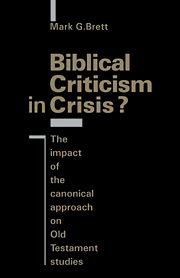Book contents
- Frontmatter
- Contents
- Acknowledgements
- List of abbreviations
- Introduction: Setting the scene
- 1 Distinguishing interpretative interests
- 2 The development of canonical exegesis
- 3 ‘Introduction’ and Old Testament theology
- 4 Has Childs fallen into Gabler's ditch?
- 5 Textual intentions and histories of reception
- 6 The future of the canonical approach
- Notes
- Bibliography
- Bibliographical key to the works of Brevard S. Childs
- Index of Old Testament references
- Index of subjects
- Index of authors
Introduction: Setting the scene
Published online by Cambridge University Press: 10 October 2009
- Frontmatter
- Contents
- Acknowledgements
- List of abbreviations
- Introduction: Setting the scene
- 1 Distinguishing interpretative interests
- 2 The development of canonical exegesis
- 3 ‘Introduction’ and Old Testament theology
- 4 Has Childs fallen into Gabler's ditch?
- 5 Textual intentions and histories of reception
- 6 The future of the canonical approach
- Notes
- Bibliography
- Bibliographical key to the works of Brevard S. Childs
- Index of Old Testament references
- Index of subjects
- Index of authors
Summary
The 1960s was a troubled decade for biblical critics who harboured theological interests. These critics witnessed the decline of an influential school of thought which, especially in the non-fundamentalist circles of North America, Britain and Germany, had promised to bridge the gap between academic studies and the use of the Bible in the churches. During the 1950s and early 1960s, the members of this so-called Biblical Theology Movement argued that theology needed to be governed by biblical categories – or more specifically by ‘Hebrew thought’ – and that these distinctive categories could be discovered through the critical study of individual Hebrew words and their etymologies. Indeed, even the Greek New Testament was thought to breathe the same Hebraic spirit. At the same time, this movement stressed that the God of the Bible was a God who acted in history, and that historical criticism was therefore the most appropriate method of biblical study. Rigorous study of the Bible in its ancient Near Eastern context would serve only to clarify the distinctiveness of the biblical traditions. In short, for the Biblical Theology Movement, the historical and critical study both of the Hebrew language and of Israelite history was of decisive theological significance.
Beginning in 1961, the foundations of this movement were undermined from several directions at once. First, James Barr formulated a detailed and devastating critique of its characteristic linguistic methods. In The Semantics of Biblical Language, he demonstrated that both the relevance of etymologies, and the conflation of ‘biblical concepts’ with particular Hebrew words, were highly problematic issues.
- Type
- Chapter
- Information
- Biblical Criticism in Crisis?The Impact of the Canonical Approach on Old Testament Studies, pp. 1 - 10Publisher: Cambridge University PressPrint publication year: 1991



